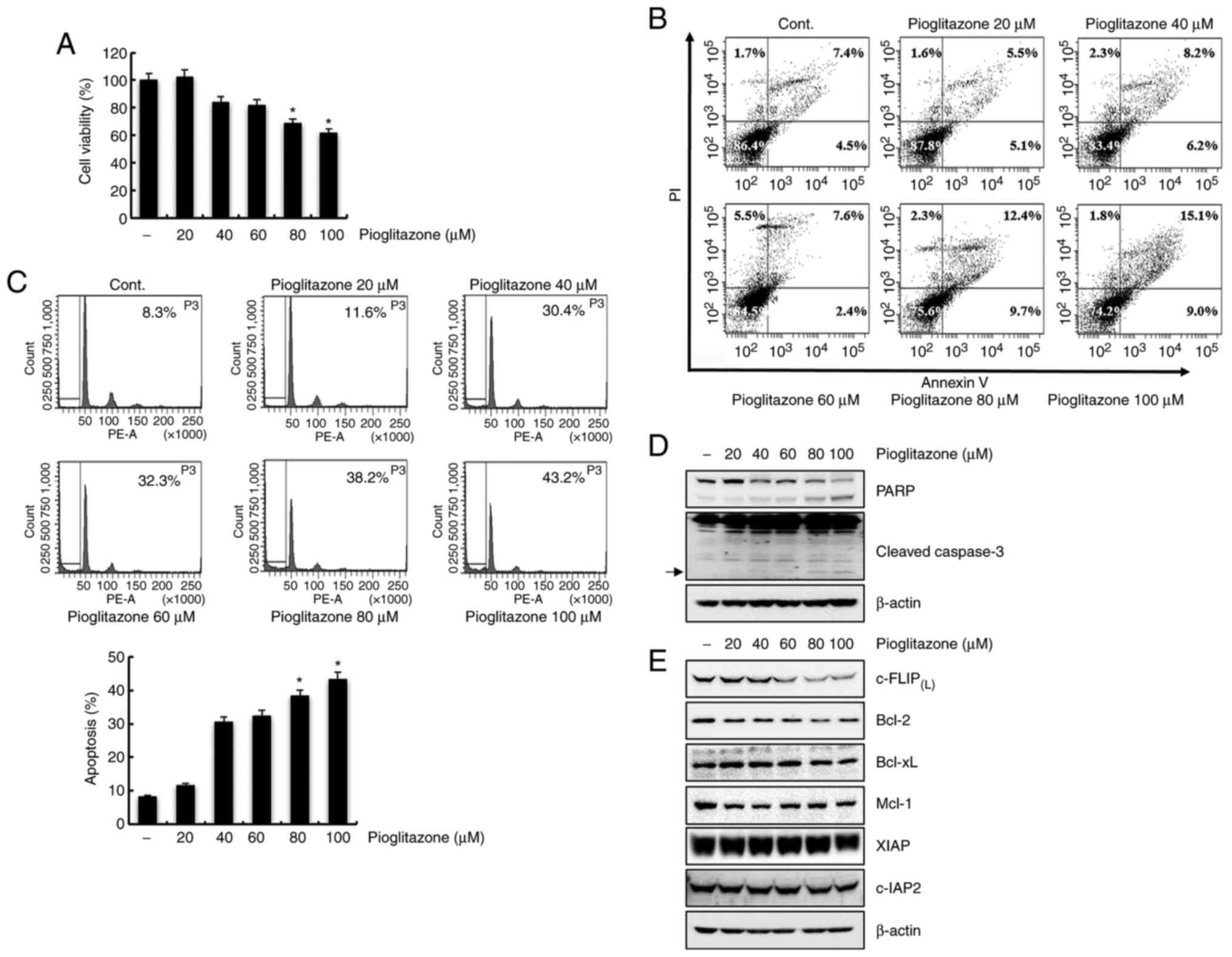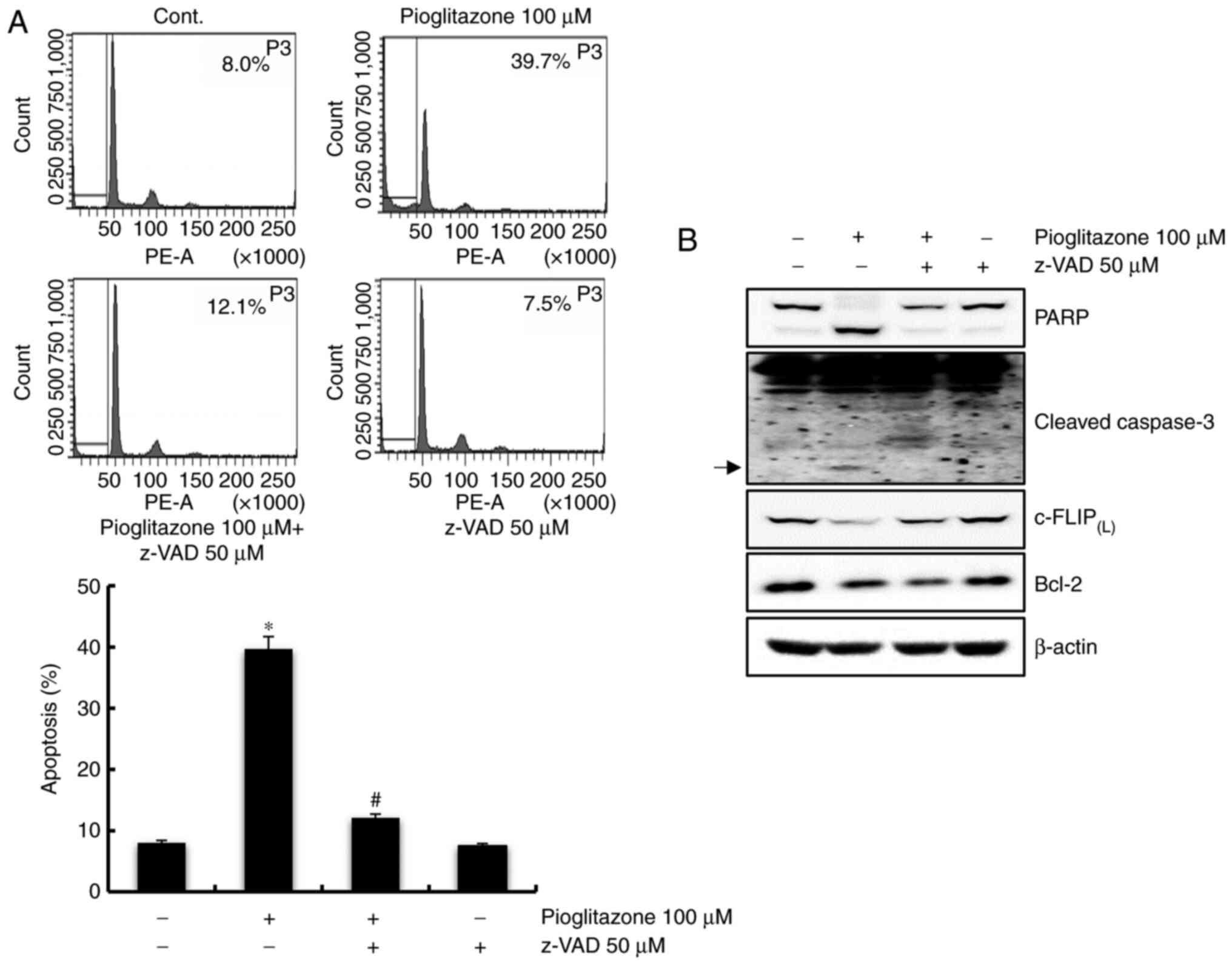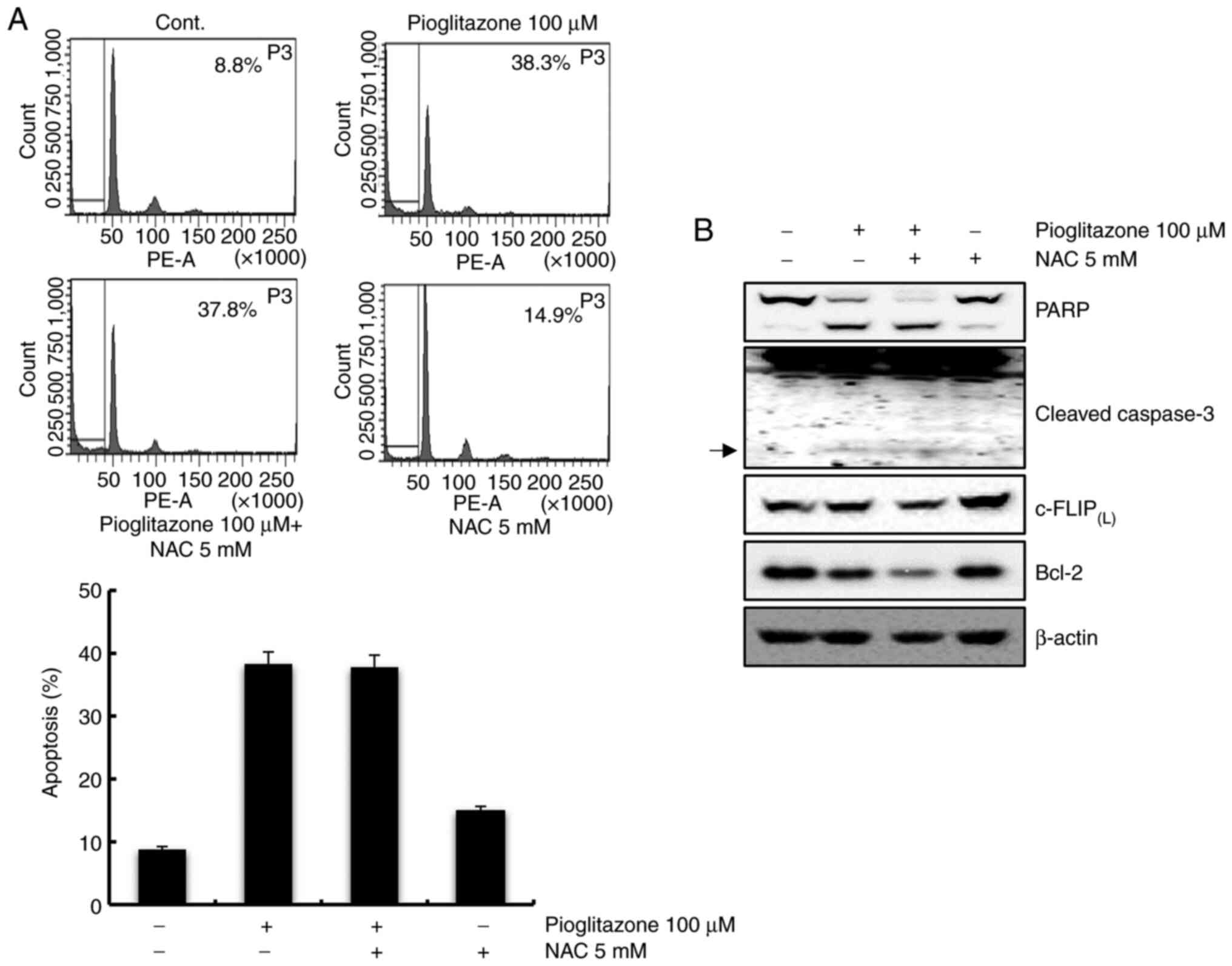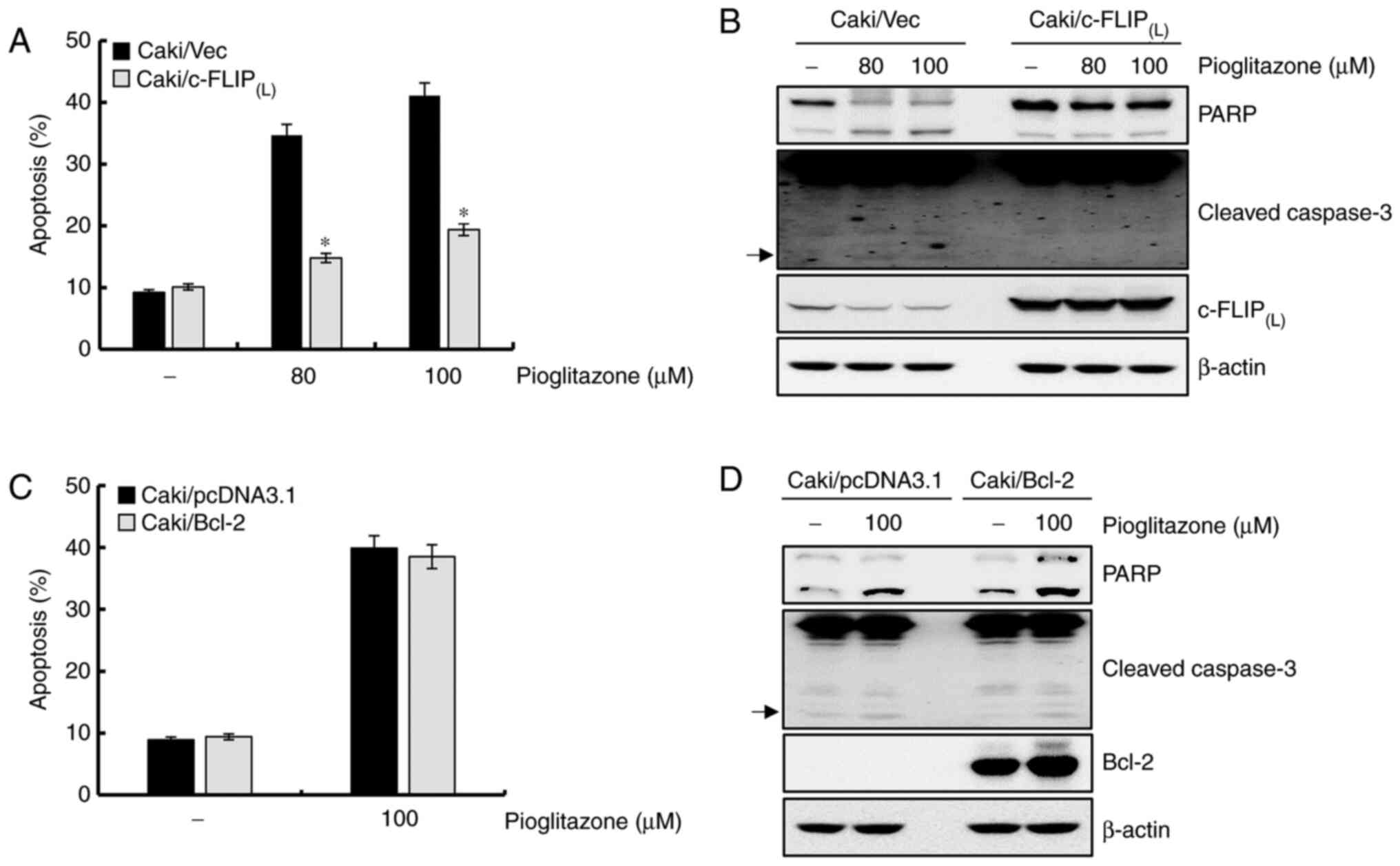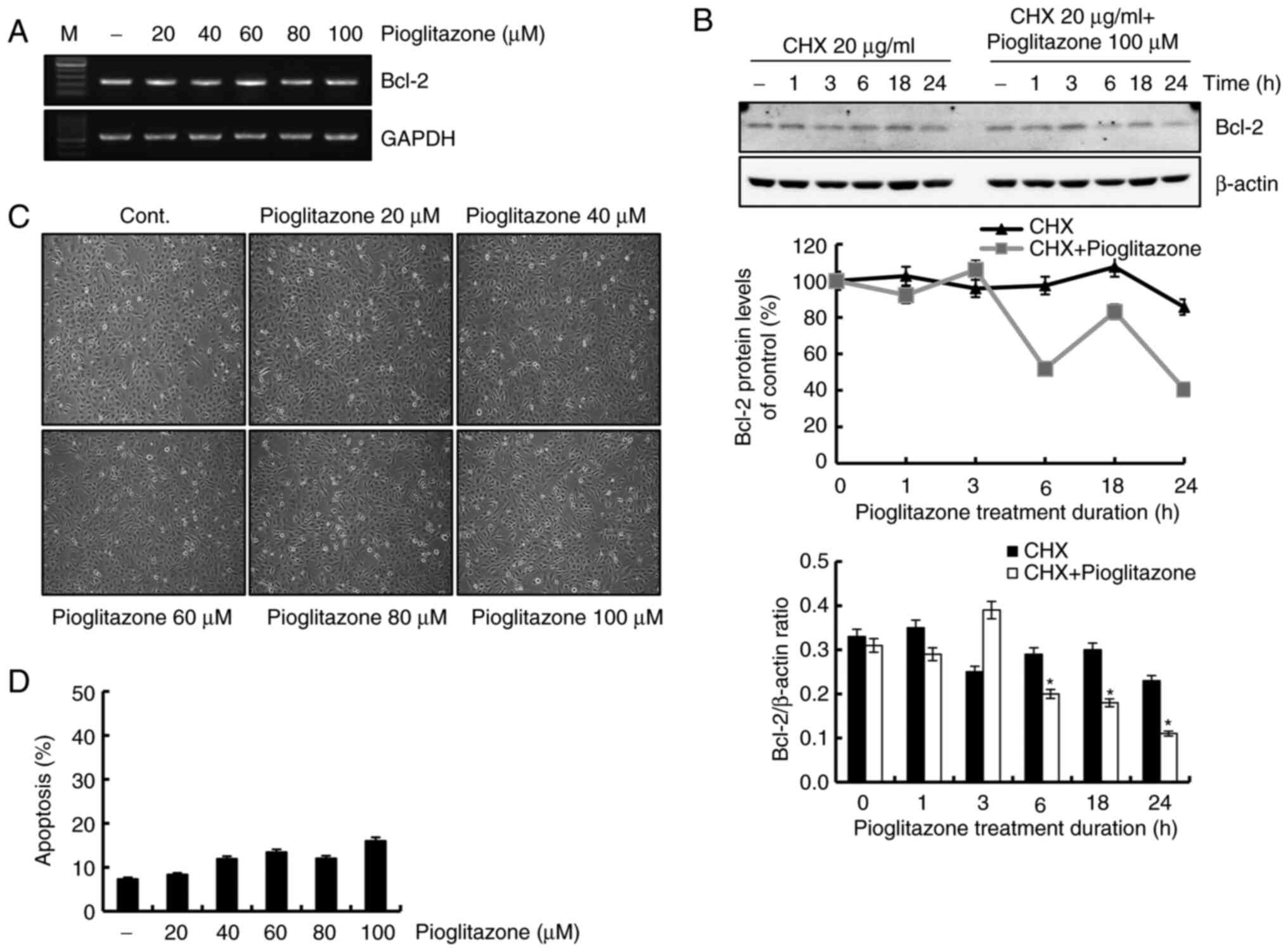|
1
|
Elrod HA and Sun SY: PPARgamma and
apoptosis in cancer. PPAR Res. 2008:7041652008. View Article : Google Scholar : PubMed/NCBI
|
|
2
|
Yang Y, Zhao LH, Huang B, Wang RY, Yuan
SX, Tao QF, Xu Y, Sun HY, Lin C and Zhou WP: Pioglitazone, a PPARγ
agonist, inhibits growth and invasion of human hepatocellular
carcinoma via blockade of the rage signaling. Mol Carcinog.
54:1584–1595. 2015. View
Article : Google Scholar : PubMed/NCBI
|
|
3
|
Heliövaara MK, Herz M, Teppo AM, Leinonen
E and Ebeling P: Pioglitazone has anti-inflammatory effects in
patients with type 2 diabetes. J Endocrinol Invest. 30:292–297.
2007. View Article : Google Scholar : PubMed/NCBI
|
|
4
|
Dromparis P, Sutendra G, Paulin R, Proctor
S, Michelakis ED and McMurtry MS: Pioglitazone inhibits
HIF-1α-dependent angiogenesis in rats by paracrine and direct
effects on endothelial cells. J Mol Med (Berl). 92:497–507. 2014.
View Article : Google Scholar : PubMed/NCBI
|
|
5
|
Tsubaki M, Takeda T, Tomonari Y, Kawashima
K, Itoh T, Imano M, Satou T and Nishida S: Pioglitazone inhibits
cancer cell growth through STAT3 inhibition and enhanced AIF
expression via a PPARγ-independent pathway. J Cell Physiol.
233:3638–3647. 2018. View Article : Google Scholar : PubMed/NCBI
|
|
6
|
Lützen U, Zhao Y, Lucht K, Zuhayra M, Marx
M, Cascorbi I and Culman J: Pioglitazone induces cell growth arrest
and activates mitochondrial apoptosis in human uterine
leiomyosarcoma cells by a peroxisome proliferator-activated
receptor γ-independent mechanism. Naunyn Schmiedebergs Arch
Pharmacol. 390:37–48. 2017. View Article : Google Scholar : PubMed/NCBI
|
|
7
|
Ozdemir Kutbay N, Biray Avci C, Sarer
Yurekli B, Caliskan Kurt C, Shademan B, Gunduz C and Erdogan M:
Effects of metformin and pioglitazone combination on apoptosis and
AMPK/mTOR signaling pathway in human anaplastic thyroid cancer
cells. J Biochem Mol Toxicol. 34:e225472020. View Article : Google Scholar : PubMed/NCBI
|
|
8
|
Koga H, Selvendiran K, Sivakumar R,
Yoshida T, Torimura T, Ueno T and Sata M: PPARgamma potentiates
anticancer effects of gemcitabine on human pancreatic cancer cells.
Int J Oncol. 40:679–685. 2012.PubMed/NCBI
|
|
9
|
Jiao XX, Lin SY, Lian SX, Qiu YR, Li ZH,
Chen ZH, Lu WQ, Zhang Y, Deng L, Jiang Y and Hu GH: The inhibition
of the breast cancer by PPARγ agonist pioglitazone through
JAK2/STAT3 pathway. Neoplasma. 67:834–842. 2020. View Article : Google Scholar : PubMed/NCBI
|
|
10
|
Safa AR: c-FLIP, a master anti-apoptotic
regulator. Exp Oncol. 34:176–184. 2012.PubMed/NCBI
|
|
11
|
Safa AR, Day TW and Wu CH: Cellular
FLICE-like inhibitory protein (C-FLIP): A novel target for cancer
therapy. Curr Cancer Drug Targets. 8:37–46. 2008. View Article : Google Scholar : PubMed/NCBI
|
|
12
|
Bagnoli M, Canevari S and Mezzanzanica D:
Cellular FLICE-inhibitory protein (c-FLIP) signalling: A key
regulator of receptor-mediated apoptosis in physiologic context and
in cancer. Int J Biochem Cell Biol. 42:210–213. 2010. View Article : Google Scholar : PubMed/NCBI
|
|
13
|
Poukkula M, Kaunisto A, Hietakangas V,
Denessiouk K, Katajamäki T, Johnson MS, Sistonen L and Eriksson JE:
Rapid turnover of c-FLIPshort is determined by its unique
C-terminal tail. J Biol Chem. 280:27345–27355. 2005. View Article : Google Scholar : PubMed/NCBI
|
|
14
|
Zhou XD, Yu JP, Liu J, Luo HS, Chen HX and
Yu HG: Overexpression of cellular FLICE-inhibitory protein (FLIP)
in gastric adenocarcinoma. Clin Sci (Lond). 106:397–405. 2004.
View Article : Google Scholar : PubMed/NCBI
|
|
15
|
Ullenhag GJ, Mukherjee A, Watson NF,
Al-Attar AH, Scholefield JH and Durrant LG: Overexpression of FLIPL
is an independent marker of poor prognosis in colorectal cancer
patients. Clin Cancer Res. 13:5070–5075. 2007. View Article : Google Scholar : PubMed/NCBI
|
|
16
|
Korkolopoulou P, Goudopoulou A, Voutsinas
G, Thomas-Tsagli E, Kapralos P, Patsouris E and Saetta AA: c-FLIP
expression in bladder urothelial carcinomas: Its role in resistance
to Fas-mediated apoptosis and clinicopathologic correlations.
Urology. 63:1198–1204. 2004. View Article : Google Scholar : PubMed/NCBI
|
|
17
|
Wang W, Wang S, Song X, Sima N, Xu X, Luo
A, Chen G, Deng D, Xu Q, Meng L, et al: The relationship between
c-FLIP expression and human papillomavirus E2 gene disruption in
cervical carcinogenesis. Gynecol Oncol. 105:571–577. 2007.
View Article : Google Scholar : PubMed/NCBI
|
|
18
|
Llambi F and Green DR: Apoptosis and
oncogenesis: Give and take in the BCL-2 family. Curr Opin Genet
Dev. 21:12–20. 2011. View Article : Google Scholar : PubMed/NCBI
|
|
19
|
Kale J, Osterlund EJ and Andrews DW: BCL-2
family proteins: Changing partners in the dance towards death. Cell
Death Differ. 25:65–80. 2018. View Article : Google Scholar : PubMed/NCBI
|
|
20
|
Kalkavan H and Green DR: MOMP, cell
suicide as a BCL-2 family business. Cell Death Differ. 25:46–55.
2018. View Article : Google Scholar : PubMed/NCBI
|
|
21
|
Ludwig LM, Maxcy KL and LaBelle JL: Flow
cytometry-based detection and analysis of BCL-2 family proteins and
mitochondrial outer membrane permeabilization (MOMP). Methods Mol
Biol. 1877:77–91. 2019. View Article : Google Scholar : PubMed/NCBI
|
|
22
|
Knight T, Luedtke D, Edwards H, Taub JW
and Ge Y: A delicate balance-The BCL-2 family and its role in
apoptosis, oncogenesis, and cancer therapeutics. Biochem Pharmacol.
162:250–261. 2019. View Article : Google Scholar : PubMed/NCBI
|
|
23
|
Inada T, Kikuyama S, Ichikawa A, Igarashi
S and Ogata Y: Bcl-2 expression as a prognostic factor of survival
of gastric carcinoma. Anticancer Res. 18:2003–2010. 1998.PubMed/NCBI
|
|
24
|
Binder C, Marx D, Overhoff R, Binder L,
Schauer A and Hiddemann W: Bcl-2 protein expression in breast
cancer in relation to established prognostic factors and other
clinicopathological variables. Ann Oncol. 6:1005–1010. 1995.
View Article : Google Scholar : PubMed/NCBI
|
|
25
|
Lee KH, Im SA, Oh DY, Lee SH, Chie EK, Han
W, Kim DW, Kim TY, Park IA, Noh DY, et al: Prognostic significance
of bcl-2 expression in stage III breast cancer patients who had
received doxorubicin and cyclophosphamide followed by paclitaxel as
adjuvant chemotherapy. BMC Cancer. 7:632007. View Article : Google Scholar : PubMed/NCBI
|
|
26
|
Azad N and Iyer AKV: Reactive oxygen
species and apoptosis. Systems Biol Free Radicals Antioxid.
113–135. 2014. View Article : Google Scholar
|
|
27
|
Han S and Roman J: Peroxisome
proliferator-activated receptor gamma: A novel target for cancer
therapeutics? Anticancer Drugs. 18:237–244. 2007. View Article : Google Scholar : PubMed/NCBI
|
|
28
|
Kostapanos MS, Elisaf MS and Mikhailidis
DP: Pioglitazone and cancer: Angel or demon? Curr Pharm Des.
19:4913–4929. 2013. View Article : Google Scholar : PubMed/NCBI
|
|
29
|
Zang C, Liu H, Posch MG, Waechter M,
Facklam M, Fenner MH, Ruthardt M, Possinger K, Phillip Koeffler H
and Elstner E: Peroxisome proliferator-activated receptor gamma
ligands induce growth inhibition and apoptosis of human B
lymphocytic leukemia. Leuk Res. 28:387–397. 2004. View Article : Google Scholar : PubMed/NCBI
|
|
30
|
Wan Z, Shi W, Shao B, Shi J, Shen A, Ma Y,
Chen J and Lan Q: Peroxisome proliferator-activated receptor γ
agonist pioglitazone inhibits β-catenin-mediated glioma cell growth
and invasion. Mol Cell Biochem. 349:1–10. 2011. View Article : Google Scholar : PubMed/NCBI
|
|
31
|
Tang H, Shi W, Fu S, Wang T, Zhai S, Song
Y and Han J: Pioglitazone and bladder cancer risk: A systematic
review and meta-analysis. Cancer Med. 7:1070–1080. 2018. View Article : Google Scholar : PubMed/NCBI
|
|
32
|
Agrawal P, Jain A, Gautam A, Nigam AK,
Pursnani N and Farooqui M: A retrospective study to assess the risk
of bladder cancer in type-2 diabetic patients treated with
pioglitazone. Perspect Clin Res. 12:9–13. 2021. View Article : Google Scholar : PubMed/NCBI
|
|
33
|
Esmaeili S, Safaroghli-Azar A,
Pourbagheri-Sigaroodi A, Salari S, Gharehbaghian A, Hamidpour M and
Bashash D: Stimulation of peroxisome proliferator-activated
receptor-gamma (PPARγ) using pioglitazone decreases the survival of
acute promyelocytic leukemia cells through up-regulation of PTEN
expression. Anticancer Agents Med Chem. 21:108–119. 2021.
View Article : Google Scholar : PubMed/NCBI
|
|
34
|
Lv S, Wang W, Wang H, Zhu Y and Lei C:
PPARγ activation serves as therapeutic strategy against bladder
cancer via inhibiting PI3K-Akt signaling pathway. BMC Cancer.
19:2042019. View Article : Google Scholar : PubMed/NCBI
|
|
35
|
Kole L, Sarkar M, Deb A and Giri B:
Pioglitazone, an anti-diabetic drug requires sustained MAPK
activation for its anti-tumor activity in MCF7 breast cancer cells,
independent of PPAR-γ pathway. Pharmacol Rep. 68:144–154. 2016.
View Article : Google Scholar : PubMed/NCBI
|
|
36
|
Zou W, Liu X, Yue P, Khuri FR and Sun SY:
PPARgamma ligands enhance TRAIL-induced apoptosis through DR5
upregulation and c-FLIP downregulation in human lung cancer cells.
Cancer Biol Ther. 6:99–106. 2007. View Article : Google Scholar : PubMed/NCBI
|
|
37
|
Lee CJ, Han JS, Seo CY, Park TH, Kwon HC,
Jeong JS, Kim IH, Yun J, Bae YS, Kwak JY and Park JI: Pioglitazone,
a synthetic ligand for PPARgamma, induces apoptosis in RB-deficient
human colorectal cancer cells. Apoptosis. 11:401–411. 2006.
View Article : Google Scholar : PubMed/NCBI
|
|
38
|
Satoh T, Toyoda M, Hoshino H, Monden T,
Yamada M, Shimizu H, Miyamoto K and Mori M: Activation of
peroxisome proliferator-activated receptor-gamma stimulates the
growth arrest and DNA-damage inducible 153 gene in non-small cell
lung carcinoma cells. Oncogene. 21:2171–2180. 2002. View Article : Google Scholar : PubMed/NCBI
|
|
39
|
Shi Y: Mechanisms of caspase activation
and inhibition during apoptosis. Mol Cell. 9:459–470. 2002.
View Article : Google Scholar : PubMed/NCBI
|
|
40
|
Shiau CW, Yang CC, Kulp SK, Chen KF and
Chen CS, Huang JW and Chen CS: Thiazolidenediones mediate apoptosis
in prostate cancer cells in part through inhibition of Bcl-xL/Bcl-2
functions independently of PPARgamma. Cancer Res. 65:1561–1569.
2005. View Article : Google Scholar : PubMed/NCBI
|
|
41
|
Fulda S: Targeting c-FLICE-like inhibitory
protein (CFLAR) in cancer. Expert Opin Ther Targets. 17:195–201.
2013. View Article : Google Scholar : PubMed/NCBI
|
|
42
|
Plissonnier ML, Fauconnet S, Bittard H,
Mougin C, Rommelaere J and Lascombe I: Cell death and restoration
of TRAIL-sensitivity by ciglitazone in resistant cervical cancer
cells. Oncotarget. 8:107744–107762. 2017. View Article : Google Scholar : PubMed/NCBI
|
|
43
|
Cui J and Placzek WJ: Post-transcriptional
regulation of anti-apoptotic BCL2 family members. Int J Mol Sci.
19:3082018. View Article : Google Scholar : PubMed/NCBI
|
|
44
|
Chen N, Hu T, Gui Y, Gao J, Li Z and Huang
S: Transcriptional regulation of Bcl-2 gene by the PR/SET domain
family member PRDM10. PeerJ. 7:e69412019. View Article : Google Scholar : PubMed/NCBI
|
|
45
|
Shim J, Kim BH, Kim YI, Kim KY, Hwangbo Y,
Jang JY, Dong SH, Kim HJ, Chang YW and Chang R: The peroxisome
proliferator-activated receptor gamma ligands, pioglitazone and
15-deoxy-Delta(12,14)-prostaglandin J(2), have antineoplastic
effects against hepatitis B virus-associated hepatocellular
carcinoma cells. Int J Oncol. 36:223–231. 2010.PubMed/NCBI
|
|
46
|
Sheikh BY, Sarker MMR, Kamarudin MNA and
Mohan G: Antiproliferative and apoptosis inducing effects of citral
via p53 and ROS-induced mitochondrial-mediated apoptosis in human
colorectal HCT116 and HT29 cell lines. Biomed Pharmacother.
96:834–846. 2017. View Article : Google Scholar : PubMed/NCBI
|
|
47
|
Yodkeeree S, Sung B, Limtrakul P and
Aggarwal BB: Zerumbone enhances TRAIL-induced apoptosis through the
induction of death receptors in human colon cancer cells: Evidence
for an essential role of reactive oxygen species. Cancer Res.
69:6581–6589. 2009. View Article : Google Scholar : PubMed/NCBI
|
|
48
|
Srivastava N, Kollipara RK, Singh DK,
Sudderth J, Hu Z, Nguyen H, Wang S, Humphries CG, Carstens R,
Huffman KE, et al: Inhibition of cancer cell proliferation by PPARγ
is mediated by a metabolic switch that increases reactive oxygen
species levels. Cell Metab. 20:650–661. 2014. View Article : Google Scholar : PubMed/NCBI
|















